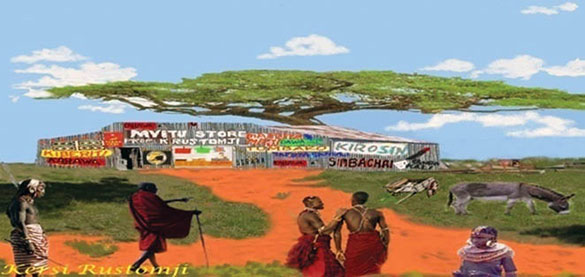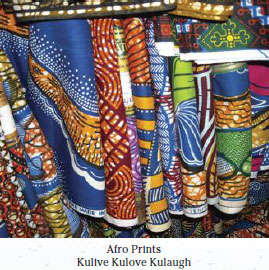|
The pioneering Indian Dukawalla or shopkeeper introduced the use of money to buy goods in Eastern Africa. Thus he launched the monetary economy in this part of the world. The Duka, derived from the Hindustani word Dukan, was set up in the remote locations after the British built the Uganda Railway at the end of the 19the century.
Housed behind the Duka, the hardy Dukawalla faced wild animals at night, hot sun during the day and isolation from his relatives and friends but he persisted and survived. Over time, he built a stone structure and then enlarged the building as his business flourished. More traders came and the sole Duka multiplied into many more and their location became a mini-township with administrative services moving in. All over Eastern Africa, these Dukas can still be seen in isolated locations and observe them as foundations of every town and city as the bazaar created by these Dukas. The Dukawalas have, in no small measure, played an important role, in the economic growth of Kenya, Uganda and Tanzania: and also Zambia and Malawi.

This poignant scene created by Kersi Rustomji realisticly depicts the virgin African bush where the enterprising Indian Dukawalla or shopkeeper constructed a tin shack, stocked it with the basic goods the African peoples were beginning to use and bartered and later sold them for produce. The signage, with spelling errors, is also typically hand painted work of the duka owners. You can almost hear the conversations of the Maasai warriors, in the foreground, deciding on what they want to buy. The advertisements in bold colours on the corrugated sheets were aimed to introduce and promote the top selling products of the day. You can hear the clinking of the five and ten cent coins with holes for threading them in a string to carry them as their robes had no pockets. The paper currency at that time was the Indian Rupee issued by the East African governments. If they had no money, they could trade their produce like vegetables or maize. Thus the Dukawalla introduced the monetary economy in Eastern Africa
The story of Dukawalla is the heroic story of hard work, persistence and survival against massive odds. Kersi Rustomji, born in Mwanza, Tanzania, grew up with these Dukas and his keen observation and attention to detail in his colourful "Ode to Indian Dukawalla" and the illustration are historic documents for the Indian diaspora. These are unsung intrepid pioneering Indian traders , very often with their families, braved the unknown hazards of the Dark Continent, carried on regardless of disease, lack of comforts, privations, ill health, and even death, which they knew was their constant and real possibility.
 "Hitherto the dukawala remain unrecognised nor given a deservedly appropriate place in the annals of these nations. Without record of these traders and other Indians who also played a very prominent and important part in the economic and the political growth of these nations, the histories of these East African countries would be incomplete," says Rustomji. "Hitherto the dukawala remain unrecognised nor given a deservedly appropriate place in the annals of these nations. Without record of these traders and other Indians who also played a very prominent and important part in the economic and the political growth of these nations, the histories of these East African countries would be incomplete," says Rustomji.
Indian traders have been active on the East African coast since Biblical times as they sailed forth and back in with the annual monsoon winds in creaky ships known as dhows. After the Indian labourers built the Ugandas Railway, some stayed back as craftsmen and opened their workshops near railway stations. Meanwhile, the traders moved inland and set up small dukas.
Braving malaria, dengue, Black Water, Sleeping Sickness and other diseases; undeterred by lions, leopards, snakes, hyenas, owls, bats and other nightly beasts; tormented by mosquitoes, Tse Tse flies, jiggers, bugs and other insects, the traders spread far inland.
On the vast sprawling, warm, savannah plains, they attracted the African tribesmen in skin robes, armed with spears, bows and arrows. Full of curiosity, first with trepidation then cautiously, they entered the duka somewhat nervously to ogle, to feel, to taste and try many new goods - sugar, salt, groundnuts, tobacco, snuff, knives, tools, weapons, bright fabrics, matches, lanterns, mugs and many more - they had seen never before. But they had no money. So the traders suggested that they bring what they produced - maize, vegetables, honey and other products - and exchange them with what they wanted. Thus began barter. Sometimes, they brought in much more than what they wanted at the moment. So the trader gave them coins they could keep and exchange for goods. Gradually, they were given currency notes of five, ten and twenty Rupees - yes, Rupees in Africa.
The traders added more goods - spices, grains, rice and lentils; basic medicines for malaria, pains and injuries; cigarettes and beer; glassware, jars pots and pans; mirrors, scissors, combs, beads, necklaces, bangles, soaps and oils; axes and farming tools. the variety increased over time. The Africans also brought more produce to barter or sell: skins, milk, charcoal, wax, coffee, cotton, millet and sorghum and other local produce. The boiled, bland African dishes gave way to spicy foods, chappatis and rice with lentils as they planted a greater variety of vegetables and fruits.
Over time, the duka was re-built with stone and the White Settlers moved in to develop their vast farms. Now the trader added brandy, whisky, rum and vodka; razors and blades; Vaseline and hair oil; shoe polish and brushes; combs, safety pins ribbons, buttons and thread, lipsticks and cream, talcum and face powders for the Bwana (boss) and his Memsahib.
The White settlers disliked derided and mistreated the Dukawala most unfairly. They said he cheats and over-charges, claimed he keeps his accounts in Indian language for the white taxman to properly assess his profits. But when the White Settler was hit by drought and his banker refused to lend him more, he came to the Dukawalla to get credit for his immediate needs and even borrow cash for his survival.
Except for Rustomji's effort, Dukawalla's contribution to nation building remains an untold story.
—Kul Bhushan worked as Business Editor for three decades in
Nairobi, Kenya, and now lives in New Delhi.
|